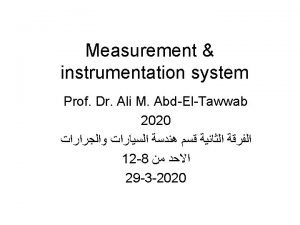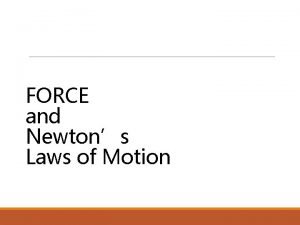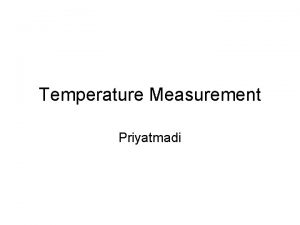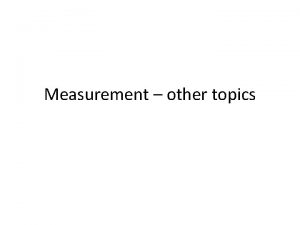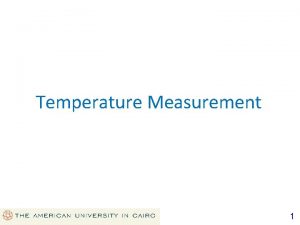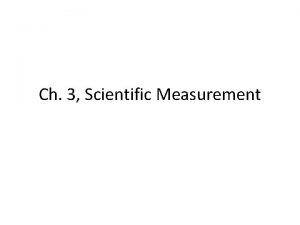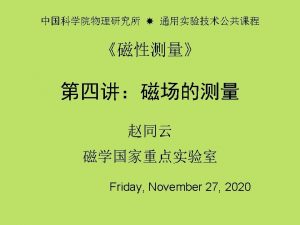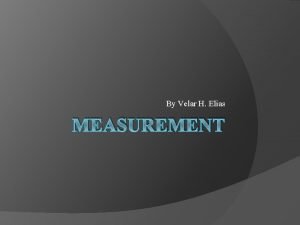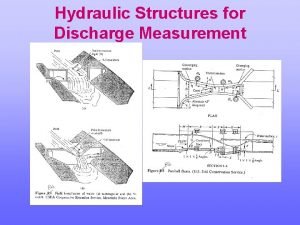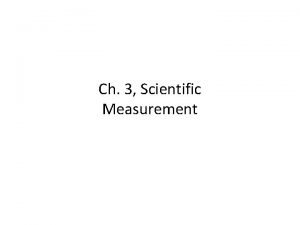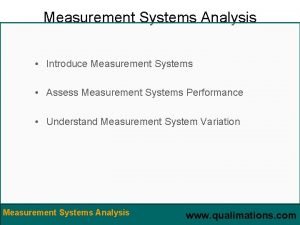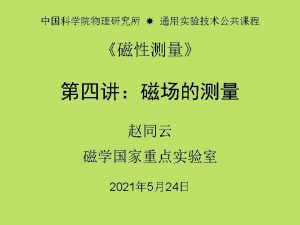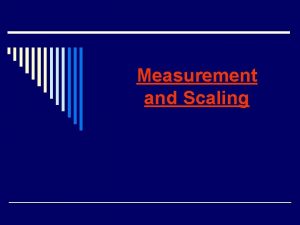Measurement of Temperature Temperature definitions Temperature is a







































- Slides: 39

Measurement of Temperature

Temperature definitions • Temperature is a measure of thermal energy in a body, which is the relative hotness or coldness of a medium and is normally measured in degrees using one of the following scales; Fahrenheit (F), Celsius or Centigrade (C), Rankine (R), or Kelvin (K). • Absolute zero is the temperature at which all molecular motion ceases or the energy of the molecule is zero

Temperature The need to convert from one temperature scale to another is a common everyday occurrence. The conversion factors are as follows: • To convert °F to °C °C = (°F − 32)5/9 • To convert °C to °F °F = (°C × 9/5) 32 • To convert °F to °R °R = °F + 459. 6 • To convert °C to K K = °C + 273. 15 • To convert K to °R °R = 1. 8 × K • To convert °R to K K = 0. 555 × °R

Methods of measurement There are several methods of measuring temperature that can be categorized as follows: 1. Expansion of a material to give visual indication, pressure, or dimensional change 2. Electrical resistance change 3. Semiconductor characteristic change 4. Voltage generated by dissimilar metals 5. Radiated energy

Devices for Temperature Measurement • Expansion thermometers – Familiar – Convenient • • • Thermocouples RTDs (Resistive Temperature Devices) Thermistors Integrated Circuits Optical pyrometers Infrared thermometers

Filled bulb thermometers


Bimetallic Thermometers


ΔL= k. LΔT The sideways displacement of the strip is much larger than the small lengthways expansion in either of the two metals • How much will a 4 -m-long copper rod at 20°C expand when the temperature is changed from 0 to 100°C?



Thermocouples Thermoelectric Circuit Vab = α(T 1 - T 2)


Measuring Thermocouple Voltage




V = α (T 1 - Tref)



Resistance Temperature Detectors • In principle, any material could be used to measure temperature if its electrical resistance changes in a significant and repeatable manner when the surrounding temperature changes • Resistance temperature devices (RTD) are either a metal film deposited on a former or are wire-wound resistors. The devices are then sealed in a glass ceramic composite material. • The electrical resistance of pure metals is positive, increasing linearly with temperature. • These devices are accurate and can be used to measure temperatures from − 300 to 1400°F (− 170 to 780°C). • In a resistance thermometer the variation of resistance with temperature is given by RT 2 = RT 1 (1 + Coeff. [T 2 − T 1])

RTD



Callendar-Van Dusen equation

For Platinum RTDs α = 0. 00392 δ = 1. 49 β = 0 if T > 0°C, and β = 0. 1 for T < 0°C

Advantages of Resistance Temperature Detectors • Linear over wide operating range • Wide temperature operating range • High temperature operating range • Good stability at high temperature Disadvantages of Resistance Temperature Detectors • Low sensitivity • Higher cost than thermocouples • No point sensing • Affected by shock and vibration

Thermistors • Like the RTD, thermistor is also a temperature-sensitive resistor. The name thermistors is derived from the term “thermally sensitive resistors, ”since the resistance of thermistor varies as a function of temperature.


Steinhart-Hart equation:


Comparison • While thermocouple is the most versatile temperature transducer and the RTD is the most linear, “most sensitive” are the words that best describe thermistors. The thermistor exhibits by far the largest value change with temperature of the three major categories of sensors. • Because thermistors are semiconductors, they are more susceptible to permanent decalibration at high temperatures than are RTDs or thermocouples. • The use of thermistors is generally limited to a few hundred degrees Celsius. (-50 to 300 degree centigrade) • Thermistors can be manufactured very small, which means they will respond quickly to temperature changes. It also means that their small thermal mass makes them susceptible to self-heating errors. • Thermistors are more fragile than RTDs or thermocouples

Application for Thermistors and RTDs • • • Coffee makers Deep fryers Fast food processing Perishable shipping Temperature controlled food storage systems Thermometers for use in food preparation

Integrated circuit temperature sensor

• Integrated-circuit temperature transducers are available in both voltage and currentoutput configurations that is linearly proportional to absolute temperature. Typical values are one microampere of current per one-degree temperature change in Kelvin (1 μA/K) and ten millivolts per one-degree change in Kelvin (10 mv/K).

• Except for the fact that these devices provide an output that is very linear with temperature, they share all the disadvantages of thermistors. • They are semiconductor devices and thus have a limited temperature range.

Fiber Optic Temperature sensors • In Industrial and Research , RF and Microwave heating applications conventional thermometers based on thermoelectric effect particularly thermocouples based on metals have limited utility as metallic objects interact with electromagnetic field. • Metallic probes absorb and reflect the energy of the microwave, so conventional thermometers are not adapted for measurement of temperature within microwaves.

Advantages of Using Fiber Optics for Temperature Measurements • Whether used for communications or infrared temperature measurement, fiber optics offer some inherent advantages for measurements in industrial and/or harsh environments: - Unaffected by electromagnetic interference (EMI) from large motors, transformers, welders and the like; - Unaffected by radio frequency interference (RFI) from wireless communications and lightning activity; - Can be positioned in hard-to-reach or view places; - Can be focused to measure small or precise locations; - Does not or will not carry electrical current (ideal for explosive hazard locations); - Fiber cables can be run in existing conduit, cable trays or be strapped onto beams, pipes or conduit (easily installed for expansions or retrofits); - Certain cables can handle ambient temperatures to over 300°C-higher with air or water purging.
 3 point circle
3 point circle Principle of measurement of temperature
Principle of measurement of temperature Anthropometric measurement includes vital signs
Anthropometric measurement includes vital signs Difference between antiferromagnetism and ferrimagnetism
Difference between antiferromagnetism and ferrimagnetism Difference between curie temperature and neel temperature
Difference between curie temperature and neel temperature Difference between curie temperature and neel temperature
Difference between curie temperature and neel temperature Recursive definitions and structural induction
Recursive definitions and structural induction Serongagandi drawing
Serongagandi drawing Resolution elements of a story
Resolution elements of a story Probability definition simple
Probability definition simple Match the vocabulary word with the correct definition
Match the vocabulary word with the correct definition Definition of financial management
Definition of financial management Vocab workshop level f unit 10
Vocab workshop level f unit 10 Level f vocab unit 1
Level f vocab unit 1 Speaker picture
Speaker picture Form bt definitions
Form bt definitions Ship stability definitions
Ship stability definitions Examples of paragraph
Examples of paragraph Mathmatical definitions
Mathmatical definitions Disaster definitions
Disaster definitions Match the criminal to the crime
Match the criminal to the crime Unit 3 lesson 2 biconditionals and definitions
Unit 3 lesson 2 biconditionals and definitions Management accounting
Management accounting Find these words
Find these words Complete the definitions with the words below
Complete the definitions with the words below Complete the definitions with the words below
Complete the definitions with the words below Define the concept of comparative education
Define the concept of comparative education Comparison between microteaching and traditional teaching
Comparison between microteaching and traditional teaching Definitions for statistics
Definitions for statistics Has no dimension; is one of the undefined terms of geometry
Has no dimension; is one of the undefined terms of geometry Circle formulas
Circle formulas Newtons laws definitions
Newtons laws definitions Definitions of solution
Definitions of solution Pradushan paribhasha
Pradushan paribhasha Cscmp definition of supply chain management
Cscmp definition of supply chain management Stop motion screw function
Stop motion screw function Operating system definitions
Operating system definitions Basic nursing definition
Basic nursing definition Visio basics
Visio basics Habit 7 sharpen the saw worksheet
Habit 7 sharpen the saw worksheet

